(All information courtesy of the instrument teams.)
![]() Previous IAU Circulars
Previous IAU Circulars
TITLE: GCN/SWIFT NOTICE
NOTICE_DATE: Mon 05 Jun 06 18:16:28 UT
NOTICE_TYPE: Swift-BAT GRB Position
TRIGGER_NUM: 213630, Seg_Num: 0
GRB_RA: 322.144d {+21h 28m 35s} (J2000),
322.228d {+21h 28m 55s} (current),
321.485d {+21h 25m 56s} (1950)
GRB_DEC: -6.060d {-06d 03' 36"} (J2000),
-6.032d {-06d 01' 54"} (current),
-6.279d {-06d 16' 44"} (1950)
GRB_ERROR: 3.00 [arcmin radius, statistical only]
GRB_INTEN: 14011 [cnts] Image_Peak=363 [image_cnts]
TRIGGER_DUR: 3.072 [sec]
TRIGGER_INDEX: 474 E_range: 25-100 keV
BKG_INTEN: 125024 [cnts]
BKG_TIME: 65702.76 SOD {18:15:02.76} UT
BKG_DUR: 32 [sec]
GRB_DATE: 13891 TJD; 156 DOY; 06/06/05
GRB_TIME: 65744.61 SOD {18:15:44.61} UT
GRB_PHI: 128.05 [deg]
GRB_THETA: 15.76 [deg]
SOLN_STATUS: 0x3
RATE_SIGNIF: 15.90 [sigma]
IMAGE_SIGNIF: 7.96 [sigma]
MERIT_PARAMS: +1 +0 +0 +2 +2 +5 +0 +0 +37 +1
SUN_POSTN: 73.66d {+04h 54m 39s} +22.59d {+22d 35' 17"}
SUN_DIST: 112.08 [deg] Sun_angle= 7.4 [hr] (West of Sun)
MOON_POSTN: 184.04d {+12h 16m 09s} -1.99d {-01d 59' 32"}
MOON_DIST: 137.49 [deg]
MOON_ILLUM: 67 [%]
GAL_COORDS: 47.02,-37.48 [deg] galactic lon,lat of the burst (or transient)
ECL_COORDS: 322.53, 8.39 [deg] ecliptic lon,lat of the burst (or transient)
COMMENTS: SWIFT-BAT GRB Coordinates.
COMMENTS: This is a rate trigger.
COMMENTS: A point_source was found.
COMMENTS: This does not match any source in the on-board catalog.
COMMENTS: This does not match any source in the ground catalog.
COMMENTS: This is a GRB.
COMMENTS: This trigger occurred at longitude,latitude = 203.98,16.69 [deg].
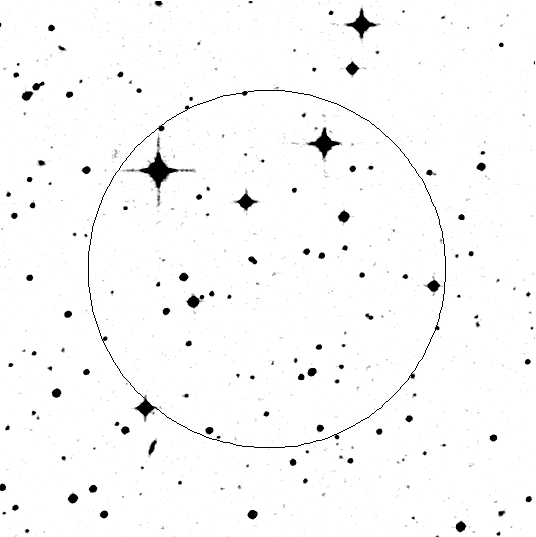
TITLE: GCN/SWIFT NOTICE
NOTICE_DATE: Mon 05 Jun 06 18:18:53 UT
NOTICE_TYPE: Swift-XRT Nack-Position
TRIGGER_NUM: 213630, Seg_Num: 0
POINT_RA: 322.160d {+21h 28m 38s} (J2000)
POINT_DEC: -6.055d {-06d 03' 16"} (J2000)
IMG_START_DATE: 13891 TJD; 156 DOY; 06/06/05
IMG_START_TIME: 65837.59 SOD {18:17:17.59} UT, 93.0 [sec] since BAT Trigger Time
COUNTS: 6 Min_needed= 20
STD_DEV: 0.00 Max_StdDev_for_Good=28.44 [arcsec]
PH2_ITER: 1 Max_iter_allowed= 4
ERROR_CODE: 1
COMMENTS: SWIFT-XRT Nack Position.
COMMENTS: No source found in the image.
TITLE: GCN/SWIFT NOTICE
NOTICE_DATE: Mon 05 Jun 06 18:20:43 UT
NOTICE_TYPE: Swift-BAT GRB Lightcurve
TRIGGER_NUM: 213630, Seg_Num: 0
GRB_RA: 322.144d {+21h 28m 35s} (J2000),
322.228d {+21h 28m 55s} (current),
321.485d {+21h 25m 56s} (1950)
GRB_DEC: -6.060d {-06d 03' 36"} (J2000),
-6.032d {-06d 01' 54"} (current),
-6.279d {-06d 16' 44"} (1950)
GRB_DATE: 13891 TJD; 156 DOY; 06/06/05
GRB_TIME: 65744.61 SOD {18:15:44.61} UT
TRIGGER_INDEX: 474
GRB_PHI: 128.05 [deg]
GRB_THETA: 15.76 [deg]
DELTA_TIME: -24.00 [sec]
TRIGGER_DUR: 3.072 [sec]
SOLN_STATUS: 0x3
RATE_SIGNIF: 15.90 [sigma]
IMAGE_SIGNIF: 7.96 [sigma]
LC_URL: sw00213630000msb.lc
SUN_POSTN: 73.66d {+04h 54m 39s} +22.59d {+22d 35' 18"}
SUN_DIST: 112.08 [deg] Sun_angle= 7.4 [hr] (West of Sun)
MOON_POSTN: 184.07d {+12h 16m 16s} -2.01d {-02d 00' 32"}
MOON_DIST: 137.46 [deg]
MOON_ILLUM: 67 [%]
GAL_COORDS: 47.02,-37.48 [deg] galactic lon,lat of the burst (or transient)
ECL_COORDS: 322.53, 8.39 [deg] ecliptic lon,lat of the burst (or transient)
COMMENTS: SWIFT-BAT GRB Lightcurve.
COMMENTS:
COMMENTS: The next comments were copied from the BAT_POS Notice:
COMMENTS: This is a rate trigger.
COMMENTS: A point_source was found.
COMMENTS: This does not match any source in the on-board catalog.
COMMENTS: This does not match any source in the ground catalog.
COMMENTS: This is a GRB.
COMMENTS: This trigger occurred at longitude,latitude = 203.98,16.69 [deg].
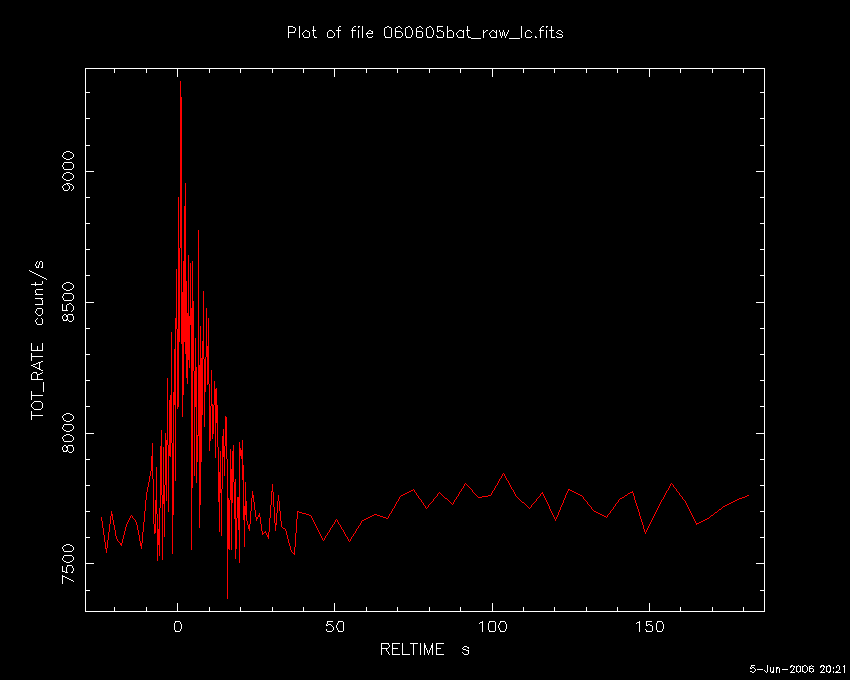
TITLE: GCN/SWIFT NOTICE
NOTICE_DATE: Mon 05 Jun 06 18:21:09 UT
NOTICE_TYPE: Swift-UVOT Source List
TRIGGER_NUM: 213630, Seg_Num: 0
POINT_RA: 322.160d {+21h 28m 38s} (J2000)
POINT_DEC: -6.055d {-06d 03' 17"} (J2000)
POINT_ROLL: 68.045d
IMG_START_DATE: 13891 TJD; 156 DOY; 06/06/05
IMG_START_TIME: 65841.35 SOD {18:17:21.35} UT, 96.7 [sec] since BAT Trigger Time
FILTER: 10, White
BKG_MEAN: 3.184
N_STARS: 74
X_OFFSET: 349 [pixels]
Y_OFFSET: 602 [pixels]
X_MAX: 1308 [pixels]
Y_MAX: 1561 [pixels]
DET_THRESH: 15
PHOTO_THRESH: 8
SL_URL: sw00213630000msufc0096.fits
SUN_POSTN: 73.66d {+04h 54m 39s} +22.59d {+22d 35' 18"}
SUN_DIST: 112.06 [deg] Sun_angle= 7.4 [hr] (West of Sun)
MOON_POSTN: 184.07d {+12h 16m 17s} -2.01d {-02d 00' 38"}
MOON_DIST: 137.47 [deg]
MOON_ILLUM: 67 [%]
GAL_COORDS: 47.03,-37.49 [deg] galactic lon,lat of the pointing direction
ECL_COORDS: 322.54, 8.39 [deg] ecliptic lon,lat of the pointing direction
COMMENTS: SWIFT-UVOT Source List.
TITLE: GCN/SWIFT NOTICE
NOTICE_DATE: Mon 05 Jun 06 18:22:48 UT
NOTICE_TYPE: Swift-UVOT Processed Source List
TRIGGER_NUM: 213630, Seg_Num: 0
POINT_RA: 322.160d {+21h 28m 38s} (J2000)
POINT_DEC: -6.055d {-06d 03' 17"} (J2000)
POINT_ROLL: 68.045d
IMG_START_DATE: 13891 TJD; 156 DOY; 06/06/05
IMG_START_TIME: 65841.35 SOD {18:17:21.35} UT, 96.7 [sec] since BAT Trigger Time
FILTER: 10, White
BKG_MEAN: 3.184
N_STARS: 74
X_OFFSET: 349 [pixels]
Y_OFFSET: 602 [pixels]
X_MAX: 1308 [pixels]
Y_MAX: 1561 [pixels]
DET_THRESH: 15
PHOTO_THRESH: 8
SL_URL: sw00213630000msufc0096.fits
SUN_POSTN: 73.67d {+04h 54m 40s} +22.59d {+22d 35' 19"}
SUN_DIST: 112.07 [deg] Sun_angle= 7.4 [hr] (West of Sun)
MOON_POSTN: 184.08d {+12h 16m 20s} -2.02d {-02d 01' 01"}
MOON_DIST: 137.46 [deg]
MOON_ILLUM: 67 [%]
GAL_COORDS: 47.03,-37.49 [deg] galactic lon,lat of the pointing direction
ECL_COORDS: 322.54, 8.39 [deg] ecliptic lon,lat of the pointing direction
COMMENTS: SWIFT-UVOT Processed Source List.
COMMENTS: All 4 attachments are included.
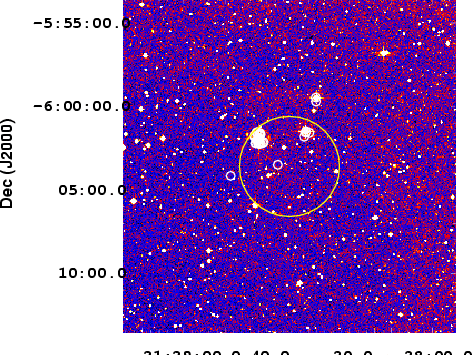
TITLE: GCN/SWIFT NOTICE
NOTICE_DATE: Mon 05 Jun 06 18:21:53 UT
NOTICE_TYPE: Swift-UVOT Image
TRIGGER_NUM: 213630, Seg_Num: 0
POINT_RA: 322.160d {+21h 28m 38s} (J2000)
POINT_DEC: -6.055d {-06d 03' 17"} (J2000)
ROLL: 68.045d
IMG_START_DATE: 13891 TJD; 156 DOY; 06/06/05
IMG_START_TIME: 65841.35 SOD {18:17:21.35} UT, 96.7 [sec] since BAT Trigger Time
FILTER: 10, White
EXPOSURE_ID: 171224242
X_OFFSET: 669 [pixels]
Y_OFFSET: 922 [pixels]
WIDTH: 160 [pixels]
HEIGHT: 160 [pixels]
X_GRB_POS: 829
Y_GRB_POS: 1082
BINNING_INDEX: 1
IM_URL: sw00213630000msuni0096.fits
SUN_POSTN: 73.66d {+04h 54m 39s} +22.59d {+22d 35' 18"}
SUN_DIST: 112.06 [deg] Sun_angle= 7.4 [hr] (West of Sun)
MOON_POSTN: 184.08d {+12h 16m 18s} -2.01d {-02d 00' 48"}
MOON_DIST: 137.46 [deg]
MOON_ILLUM: 67 [%]
GAL_COORDS: 47.03,-37.49 [deg] galactic lon,lat of the pointing direction
ECL_COORDS: 322.54, 8.39 [deg] ecliptic lon,lat of the pointing direction
COMMENTS: SWIFT-UVOT Image.
COMMENTS: The GRB Position came from the Window Position in the Mode Command.
COMMENTS: The image has 2x2 binning (compression).
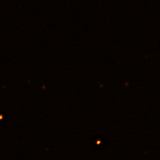
TITLE: GCN/SWIFT NOTICE
NOTICE_DATE: Mon 05 Jun 06 18:32:41 UT
NOTICE_TYPE: Swift-UVOT Source List
TRIGGER_NUM: 213630, Seg_Num: 0
POINT_RA: 322.162d {+21h 28m 39s} (J2000)
POINT_DEC: -6.056d {-06d 03' 20"} (J2000)
POINT_ROLL: 68.045d
IMG_START_DATE: 13891 TJD; 156 DOY; 06/06/05
IMG_START_TIME: 65946.61 SOD {18:19:06.61} UT, 202.0 [sec] since BAT Trigger Time
FILTER: 3, V
BKG_MEAN: 4.359
N_STARS: 154
X_OFFSET: 349 [pixels]
Y_OFFSET: 602 [pixels]
X_MAX: 1308 [pixels]
Y_MAX: 1561 [pixels]
DET_THRESH: 17
PHOTO_THRESH: 10
SL_URL: sw00213630000msufc0202.fits
SUN_POSTN: 73.67d {+04h 54m 41s} +22.59d {+22d 35' 21"}
SUN_DIST: 112.07 [deg] Sun_angle= 7.4 [hr] (West of Sun)
MOON_POSTN: 184.15d {+12h 16m 37s} -2.06d {-02d 03' 22"}
MOON_DIST: 137.38 [deg]
MOON_ILLUM: 67 [%]
GAL_COORDS: 47.03,-37.50 [deg] galactic lon,lat of the pointing direction
ECL_COORDS: 322.54, 8.39 [deg] ecliptic lon,lat of the pointing direction
COMMENTS: SWIFT-UVOT Source List.
TITLE: GCN/SWIFT NOTICE
NOTICE_DATE: Mon 05 Jun 06 18:23:02 UT
NOTICE_TYPE: Swift-UVOT Processed Image
TRIGGER_NUM: 213630, Seg_Num: 0
POINT_RA: 322.160d {+21h 28m 38s} (J2000)
POINT_DEC: -6.055d {-06d 03' 17"} (J2000)
ROLL: 68.045d
IMG_START_DATE: 13891 TJD; 156 DOY; 06/06/05
IMG_START_TIME: 65841.35 SOD {18:17:21.35} UT, 96.7 [sec] since BAT Trigger Time
FILTER: 10, White
EXPOSURE_ID: 171224242
X_OFFSET: 669 [pixels]
Y_OFFSET: 922 [pixels]
WIDTH: 160 [pixels]
HEIGHT: 160 [pixels]
X_GRB_POS: 829
Y_GRB_POS: 1082
BINNING_INDEX: 1
IM_URL: sw00213630000msuni0096.fits
SUN_POSTN: 73.67d {+04h 54m 40s} +22.59d {+22d 35' 19"}
SUN_DIST: 112.07 [deg] Sun_angle= 7.4 [hr] (West of Sun)
MOON_POSTN: 184.08d {+12h 16m 20s} -2.02d {-02d 01' 05"}
MOON_DIST: 137.46 [deg]
MOON_ILLUM: 67 [%]
GAL_COORDS: 47.03,-37.49 [deg] galactic lon,lat of the pointing direction
ECL_COORDS: 322.54, 8.39 [deg] ecliptic lon,lat of the pointing direction
COMMENTS: SWIFT-UVOT Processed Image.
COMMENTS: The GRB Position came from the Window Position in the Mode Command.
COMMENTS: The image has 2x2 binning (compression).
COMMENTS: All 4 attachments are included.
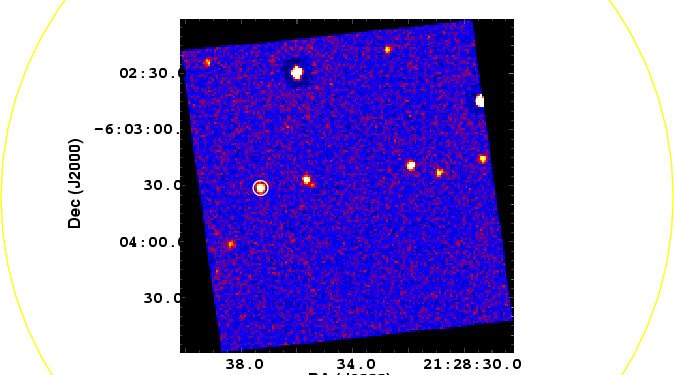
TITLE: GCN/SWIFT NOTICE
NOTICE_DATE: Mon 05 Jun 06 18:33:43 UT
NOTICE_TYPE: Swift-UVOT Processed Source List
TRIGGER_NUM: 213630, Seg_Num: 0
POINT_RA: 322.162d {+21h 28m 39s} (J2000)
POINT_DEC: -6.056d {-06d 03' 20"} (J2000)
POINT_ROLL: 68.045d
IMG_START_DATE: 13891 TJD; 156 DOY; 06/06/05
IMG_START_TIME: 65946.61 SOD {18:19:06.61} UT, 202.0 [sec] since BAT Trigger Time
FILTER: 3, V
BKG_MEAN: 4.359
N_STARS: 154
X_OFFSET: 349 [pixels]
Y_OFFSET: 602 [pixels]
X_MAX: 1308 [pixels]
Y_MAX: 1561 [pixels]
DET_THRESH: 17
PHOTO_THRESH: 10
SL_URL: sw00213630000msufc0202.fits
SUN_POSTN: 73.67d {+04h 54m 42s} +22.59d {+22d 35' 22"}
SUN_DIST: 112.07 [deg] Sun_angle= 7.4 [hr] (West of Sun)
MOON_POSTN: 184.16d {+12h 16m 39s} -2.06d {-02d 03' 36"}
MOON_DIST: 137.37 [deg]
MOON_ILLUM: 67 [%]
GAL_COORDS: 47.03,-37.50 [deg] galactic lon,lat of the pointing direction
ECL_COORDS: 322.54, 8.39 [deg] ecliptic lon,lat of the pointing direction
COMMENTS: SWIFT-UVOT Processed Source List.
COMMENTS: All 4 attachments are included.
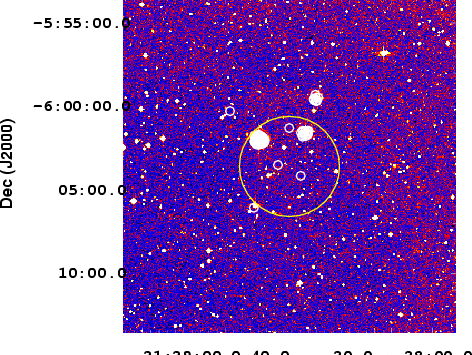
TITLE: GCN/SWIFT NOTICE
NOTICE_DATE: Mon 05 Jun 06 18:34:09 UT
NOTICE_TYPE: Swift-UVOT Image
TRIGGER_NUM: 213630, Seg_Num: 0
POINT_RA: 322.162d {+21h 28m 39s} (J2000)
POINT_DEC: -6.056d {-06d 03' 20"} (J2000)
ROLL: 68.045d
IMG_START_DATE: 13891 TJD; 156 DOY; 06/06/05
IMG_START_TIME: 65946.61 SOD {18:19:06.61} UT, 202.0 [sec] since BAT Trigger Time
FILTER: 3, V
EXPOSURE_ID: 171224347
X_OFFSET: 669 [pixels]
Y_OFFSET: 922 [pixels]
WIDTH: 160 [pixels]
HEIGHT: 160 [pixels]
X_GRB_POS: 829
Y_GRB_POS: 1082
BINNING_INDEX: 1
IM_URL: sw00213630000msuni0202.fits
SUN_POSTN: 73.67d {+04h 54m 42s} +22.59d {+22d 35' 22"}
SUN_DIST: 112.07 [deg] Sun_angle= 7.4 [hr] (West of Sun)
MOON_POSTN: 184.16d {+12h 16m 40s} -2.06d {-02d 03' 42"}
MOON_DIST: 137.37 [deg]
MOON_ILLUM: 67 [%]
GAL_COORDS: 47.03,-37.50 [deg] galactic lon,lat of the pointing direction
ECL_COORDS: 322.54, 8.39 [deg] ecliptic lon,lat of the pointing direction
COMMENTS: SWIFT-UVOT Image.
COMMENTS: The GRB Position came from the Window Position in the Mode Command.
COMMENTS: The image has 2x2 binning (compression).

TITLE: GCN/SWIFT NOTICE
NOTICE_DATE: Mon 05 Jun 06 18:35:01 UT
NOTICE_TYPE: Swift-UVOT Processed Image
TRIGGER_NUM: 213630, Seg_Num: 0
POINT_RA: 322.162d {+21h 28m 39s} (J2000)
POINT_DEC: -6.056d {-06d 03' 20"} (J2000)
ROLL: 68.045d
IMG_START_DATE: 13891 TJD; 156 DOY; 06/06/05
IMG_START_TIME: 65946.61 SOD {18:19:06.61} UT, 202.0 [sec] since BAT Trigger Time
FILTER: 3, V
EXPOSURE_ID: 171224347
X_OFFSET: 669 [pixels]
Y_OFFSET: 922 [pixels]
WIDTH: 160 [pixels]
HEIGHT: 160 [pixels]
X_GRB_POS: 829
Y_GRB_POS: 1082
BINNING_INDEX: 1
IM_URL: sw00213630000msuni0202.fits
SUN_POSTN: 73.67d {+04h 54m 42s} +22.59d {+22d 35' 22"}
SUN_DIST: 112.07 [deg] Sun_angle= 7.4 [hr] (West of Sun)
MOON_POSTN: 184.17d {+12h 16m 41s} -2.07d {-02d 03' 55"}
MOON_DIST: 137.36 [deg]
MOON_ILLUM: 67 [%]
GAL_COORDS: 47.03,-37.50 [deg] galactic lon,lat of the pointing direction
ECL_COORDS: 322.54, 8.39 [deg] ecliptic lon,lat of the pointing direction
COMMENTS: SWIFT-UVOT Processed Image.
COMMENTS: The GRB Position came from the Window Position in the Mode Command.
COMMENTS: The image has 2x2 binning (compression).
COMMENTS: If you have elected to receive attachments:
COMMENTS: The uvot_catalog_image.fits.gz file does not exist; skipping the attachment.
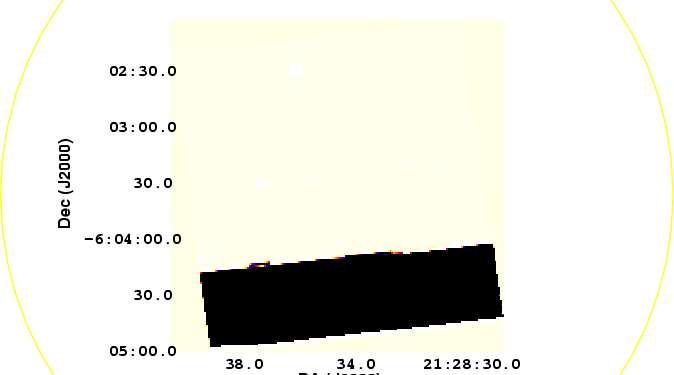
TITLE: GCN/SWIFT NOTICE
NOTICE_DATE: Mon 05 Jun 06 18:35:03 UT
NOTICE_TYPE: Swift-UVOT Position
TRIGGER_NUM: 213630, Seg_Num: 0
GRB_RA: 322.1555d {+21h 28m 37.3s} (J2000),
322.2402d {+21h 28m 57.6s} (current),
321.4964d {+21h 25m 59.1s} (1950)
GRB_DEC: -6.0586d {-06d 03' 30.9"} (J2000),
-6.0303d {-06d 01' 49.1"} (current),
-6.2775d {-06d 16' 38.8"} (1950)
GRB_ERROR: 0.7 [arcsec radius, statistical only]
GRB_MAG: 17.39 +/- 0.50 [mag]
FILTER: 10, White
IMG_START_DATE: 13891 TJD; 156 DOY; 06/06/05
IMG_START_TIME: 65842.60 SOD {18:17:22.60} UT, 98.0 [sec] since BAT Trigger Time
SUN_POSTN: 73.67d {+04h 54m 42s} +22.59d {+22d 35' 22"}
SUN_DIST: 112.08 [deg] Sun_angle= 7.4 [hr] (West of Sun)
MOON_POSTN: 184.17d {+12h 16m 41s} -2.07d {-02d 03' 55"}
MOON_DIST: 137.35 [deg]
MOON_ILLUM: 67 [%]
GAL_COORDS: 47.03,-37.49 [deg] galactic lon,lat of the burst (or transient)
ECL_COORDS: 322.54, 8.39 [deg] ecliptic lon,lat of the burst (or transient)
COMMENTS: SWIFT UVOT Position Notice.
COMMENTS: This Notice was ground-generated -- not flight-generated.
TITLE: GCN/SWIFT NOTICE
NOTICE_DATE: Mon 05 Jun 06 18:36:10 UT
NOTICE_TYPE: Swift-XRT Position
TRIGGER_NUM: 213630, Seg_Num: 0
GRB_RA: 322.1548d {+21h 28m 37.1s} (J2000),
322.2395d {+21h 28m 57.4s} (current),
321.4957d {+21h 25m 58.9s} (1950)
GRB_DEC: -6.0598d {-06d 03' 35.2"} (J2000),
-6.0315d {-06d 01' 53.5"} (current),
-6.2787d {-06d 16' 43.1"} (1950)
GRB_ERROR: 3.6 [arcsec radius, statistical plus systematic, 90% containment]
GRB_INTEN: 9.99e-12 [erg/cm2/sec]
GRB_SIGNIF: 5.00 [sigma]
IMG_START_DATE: 13891 TJD; 156 DOY; 06/06/05
IMG_START_TIME: 65837.00 SOD {18:17:17.00} UT, 92.4 [sec] since BAT Trigger Time
TAM[0-3]: 327.61 237.19 261.35 242.66
AMPLIFIER: 2
WAVEFORM: 134
SUN_POSTN: 73.67d {+04h 54m 42s} +22.59d {+22d 35' 22"}
SUN_DIST: 112.08 [deg] Sun_angle= 7.4 [hr] (West of Sun)
MOON_POSTN: 184.18d {+12h 16m 43s} -2.07d {-02d 04' 11"}
MOON_DIST: 137.35 [deg]
MOON_ILLUM: 67 [%]
GAL_COORDS: 47.03,-37.49 [deg] galactic lon,lat of the burst
ECL_COORDS: 322.54, 8.39 [deg] ecliptic lon,lat of the burst
COMMENTS: SWIFT-XRT Coordinates.
COMMENTS: This Notice was ground-generated -- not flight-generated.
COMMENTS: TAM values are not valid.
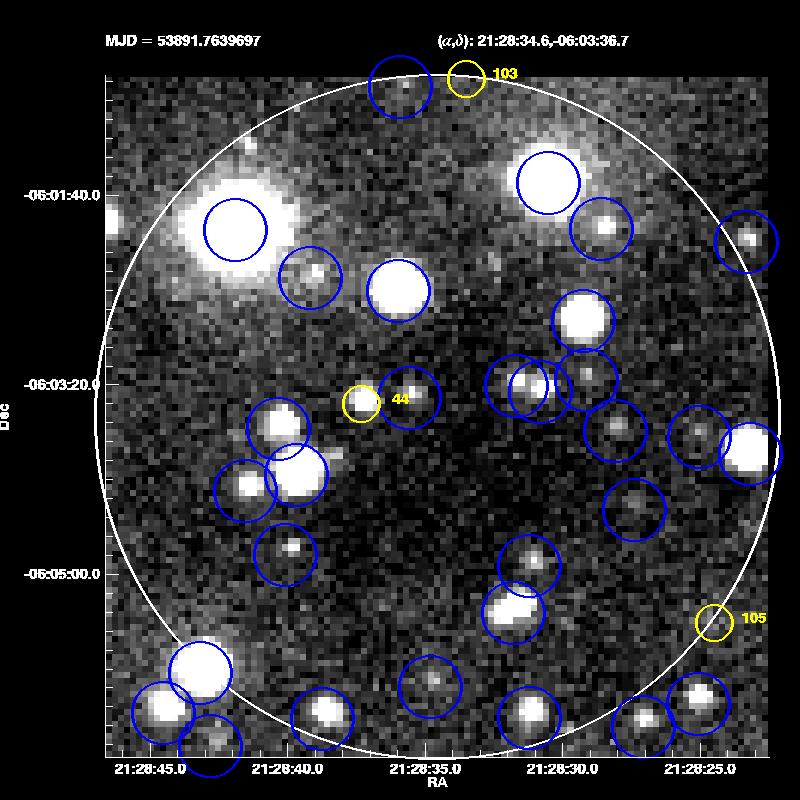
t-t0 m_R err
5.62 19.767 0.03
5.83 19.873 0.03
6.17 19.911 0.03
6.37 20.010 0.04
The power-law decay index in R is -1.6+-0.3 between 5.62 and 6.37 hours
after the burst. Comparing our decay slope with that derived from
earlier ROTSE data (Schaefer et al., GCN 5222) we conclude that there
was a break in OT light curve between 1 and 5 hours after the burst.
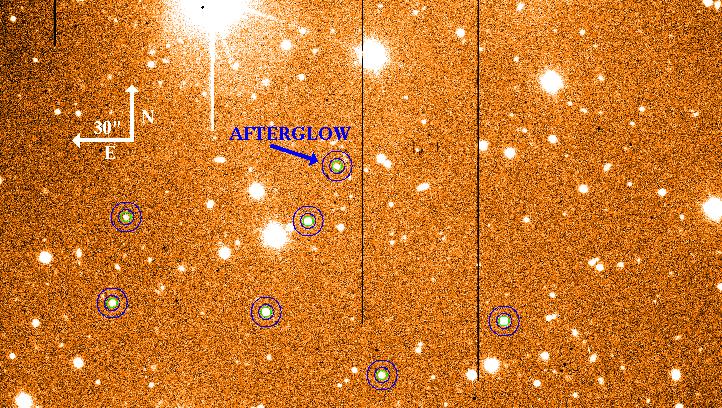
RA(J2000) = 21h 28m 37.16s Dec(J2000) = -06d 03' 33.8"with an uncertainty of 3.6 arcsec (90% containment). This is 0.7 and 2.7 arcsec from the on-board XRT and UVOT positions respectively and 38.8 arcsec from the on-board BAT position given in GCN 5221 by Page et al.
Filter T_range(s) Exp(s) Mag/3sig_UL V 202-595 386 16.53 +/- 0.04 V 10172-10471 291 19.0 +/- 0.2 B 4388-4588 190 20.0 +/- 0.2 B 23023-23322 287 21 +/- 1 U 4184-23017 2140 21.1 (3sig_UL) UVW1 3979-22104 2030 20.2 (3sig_UL) UVM2 3774-11377 1267 20.7 (3sig_UL) UVW2 4798-6381 338 19.9 (3sig_UL) White 97-197 98 17.64 +/- 0.06 White 17477-17776 291 20.5 +/- 0.3These values are not corrected for the estimated Galactic extinction of E(B-V) = 0.049.
t-t0 m_R err
31.1 23.0 0.2
Using all data (Khamitov et al., GCN5224) we estimate the power-law decay
index in R as -1.7+-0.02, which did not changed since ~5.6 hours after the
burst.
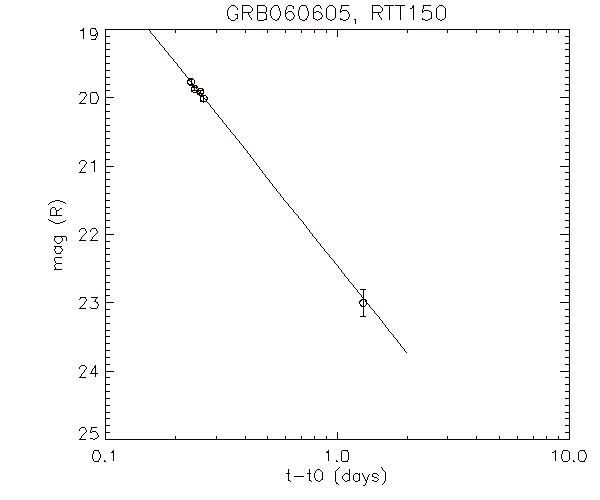
Filter Start (UT) Stop (UT) Exposure Total (hr) Telescope V 08:20:36 09:43:56 160s x 26 1.2 TTT Red* 06:55:02 10:10:50 160s x 32 1.4 TTT V 09:47:32 11:32:12 160s x 38 1.7 GORT B 08:47:59 09:44:22 160s x 21 0.9 GORTObservations were taken under poor conditions. We do not detect the afterglow (Rykoff et al., GCN 5220) down to 3-sigma limiting magnitudes of V > 20.0 at a mean time of 14.8 hours, Red > 18.5 at 13.4 hours with TTT, and V > 19.1, B > 16.7 at 16.4 and 15.0 hours respectively with GORT.